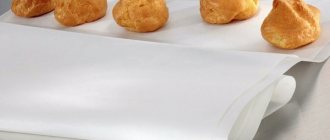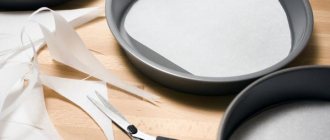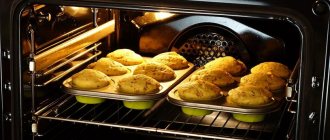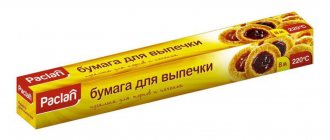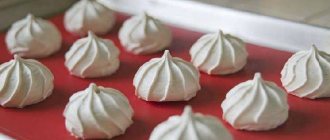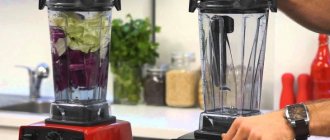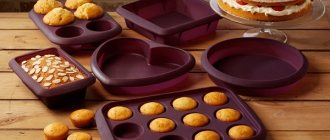How to properly use parchment paper? You will find answers to this and other questions below in the article.
Confectioners began using parchment to make baked goods back in the last century. Such paper can be purchased at any hardware store, eco-goods store, grocery store, supermarket or market.
- Almost every housewife has parchment, but many do not know what it is for, and often such paper is used for other purposes.
- What is parchment? Where can I buy such paper? How to use it correctly to make baked goods tasty and healthy?
- You can find answers to these and other questions in this article.
What is parchment
Baking paper used to be a common item in grocery stores. They wrapped food in it, not knowing what valuable qualities it possessed. To make parchment, huge sheets of cellulose (porous paper) are used. During the production process, they are treated with solutions of special acids, resulting in hydrolysis.
The resulting parchment is washed in several waters, followed by drying. The finished paper is cut into smaller sheets, rolled and packaged. In this form, parchment paper goes on sale. Thanks to special processing, it is able to withstand high temperatures, in addition, it does not limp when wet.
Pie with apples step by step with photos
Melt the butter in a frying pan, let it cool, then add sour cream, mix everything
Mix salt, cinnamon, flour and sugar. Add all this to the butter and sour cream mixture.
Knead the dough, divide it into 2 parts, then roll them out
Place parchment paper on a baking sheet and place the first layer of dough
Finely chop the apples and sprinkle them with lemon juice
Place apples on the first sheet of dough and fill them with cream. Then cover everything with a second sheet of dough and seal the edges
Preheat the oven to 200 degrees
After 25 minutes our delicious and tender pie is ready
Which side should you put on the baking sheet?
If you look closely at the baking paper, you will notice that its sides, like those of foil, differ from each other. Before using parchment for baking, you need to understand which side to lay it on the baking sheet.
It is necessary to lay the paper with the glossy side up, this will help distribute the temperature more evenly over the surface. Experienced housewives, before the widespread appearance of parchment, used ordinary notebook sheets, pre-treating them with vegetable oil.
Making cupcakes in paper tins
Ingredients:
- 3 chicken eggs;
- half a glass of granulated sugar;
- mayonnaise – 100 g;
- 0.5 tsp. slaked soda;
- 120 g peasant butter (pre-melted);
- Wheat flour;
- raisins, dried apricots, prunes.
Preparation steps:
To lubricate or not
Despite the popularity of baking paper in modern cooking, not everyone knows whether it needs to be greased with vegetable oil before putting it in the oven. The answer to this question can be found on the packaging of the parchment. Some manufacturers treat sheets of paper with silicone, indicating this fact in the product characteristics. In this case, no additional manipulations are required. The baked goods are placed on parchment and sent to the oven.
If there is no impregnation marking on the package, the sheet can be coated with butter or vegetable oil. However, if you are planning to bake shortcrust pastry, you should not do this. The fat released from the product as the temperature rises will ensure the processing of the parchment.
What to do to prevent baked goods from sticking?
There are several ways you can prevent baked goods from sticking. It all depends on whether baking will be done in a mold or on a baking sheet covered with parchment paper or foil. Each case has its own nuances.
To the parchment
To prevent products from sticking to parchment paper when baking, you should choose high-quality material. Also, do not forget to generously grease the parchment with vegetable or butter. In addition, you can sprinkle the surface:
- wheat flour;
- breadcrumbs;
- semolina.
If you look closely at parchment paper, it is shiny on one side and slightly matte on the other. The shine indicates the presence of a thin layer of food-grade silicone, and it is on this side that the dough should be placed.
Responsible manufacturers make silicone coating on both sides. It may not always be smooth, for example, as shown in the photo.
To silicone mold
The silicone mold is specially designed so that nothing sticks in it. Therefore, no additional manipulations are required here other than preparatory ones (wash and dry the mold).
However, keep in mind these simple recommendations:
- Before first use, grease the pan with oil. If there are concerns, you can repeat the procedure before each baking.
- Choose containers without reliefs or patterns. Housewives note that baked goods stick to decorative surfaces more often.
- After use, soak the mold for 10 minutes in cold water. Then the remaining dough comes off better, and you don’t have to put in a lot of effort to remove them.
Please note that baking in a silicone pan cooks faster than in a metal pan. Therefore, you need to carefully monitor the temperature.
To the foil
If there is nothing in the house suitable for baking except foil, then with it you can follow the same tips as with parchment paper (grease generously and sprinkle with flour, breadcrumbs or semolina).
If the baking area is small, then removing the foil will be easy, but if it is a large pie or pizza, then problems may arise. And even abundant lubrication will not help.
Butter buns
Fans of homemade baking often encounter such a nuisance as burning. In addition, products with filling often leave black fried marks on the baking sheet, which are quite difficult to wash off. If you know how to use parchment for baking buns, this problem can be easily avoided.
If you are planning to make buns at home, you should get some parchment paper. The sheet is spread on a dry and clean baking sheet, if necessary, the protruding edges are trimmed and greased with vegetable oil. The dough is placed on parchment and left to rise in a warm place.
If you need to quickly prepare baked goods and there is no way to buy special paper, it can be easily replaced.
- You can use tracing paper instead of parchment. It is often used when sewing or drawing. This paper is thinner but has similar quality to processed pulp. Having covered the baking sheet, it must be coated with oil or fat.
- Foil, also greased with oil, is often used as a substitute for parchment. However, you should carefully monitor the baking. Thin metallized paper can increase the temperature, thereby speeding up the cooking process.
- Recently, many housewives have been using silicone baking products. These are all kinds of rugs, molds for bread, cookies, and cakes. Using them in the kitchen, you can do without parchment.
- Use the tools at hand to effectively replace baking paper. Notebook, landscape, oiled sheets, baking sleeve, treated with fat. Even a foil wrapper for butter can successfully replace popular paper.
To avoid troubles, you should not use newspapers, cardboard, plastic bags, or plain paper for baking without pre-oiling.
Other means
Parchment paper for baking can be replaced with a regular flour bag. As a rule, such a bag is made of thick parchment paper. Cut out the desired shape and place on a baking sheet. The parchment can be greased with butter. If you are baking cookies or a cake with a high fat content, you can even lay out the dough on dry paper.
When using other products instead of parchment paper, make sure the oven temperature is not too high.
Some people use a regular A4 or A3 sheet depending on the size of the baking tray. Before baking, such paper should be thoroughly soaked in vegetable or melted butter. But still, the risk of burning is very high. Therefore, it is not recommended to resort to this method when baking at high temperatures for a long time.
If you don't have any materials at home that can replace parchment paper, use semolina, breadcrumbs or wheat flour. If possible, bake the dough on a non-stick baking sheet. Be sure to lubricate the bottom and sides with oil or fat.
Cake layers
Parchment paper is very convenient to use when baking cake layers for various cakes. They often come in a wide variety of shapes and thicknesses. It happens that when baking a thick cake, the top quickly browns and begins to burn. The cake itself remains raw. In this case, a sheet of parchment paper is oiled and the surface of the dough is covered with it.
Using parchment for baking cakes, like any other product, is very simple. It is enough to adjust a sheet of paper to the size of the mold using a knife or scissors, grease it with vegetable oil if necessary and lay out the dough. It happens that after cooking, the parchment is firmly fried to the cake. To separate it, there are several ways:
- wipe the slightly cooled paper with a damp cloth to soak it;
- you can cut the leaf with a knife with a long, thin blade;
- Place the mold with the hot cake on a damp cloth and hold for 10-15 minutes.
If the problem with paper recurs frequently, it is better to use a product from another company.
Cookies with chocolate
Components:
- 250 g chocolate or cocoa;
- 50 g peasant butter;
- powdered sugar – 1 tbsp;
- 4 chicken eggs;
- vanillin;
- Wheat flour;
- 1 packet of baking powder.
Cooking algorithm:
- If chocolate is used, it must be melted first. Then mix with butter and add sugar. Mix everything well. It is advisable to add sugar to the warm mixture so that it melts. If this moment is missed, then the prepared mass can be kept on fire.
- Add eggs, vanillin, flour, baking powder and mix thoroughly. Place the prepared mixture in the refrigerator for 1 hour. Cover with film to prevent the dough from drying out.
- After an hour, you need to take out the dough, roll it out and cut out any shapes.
- Take a baking sheet, cover it with paper, oil it and lay out the cookies, which you first need to dip in powdered sugar.
Cookies bake very quickly, on average 20 minutes.
Homemade pie
Many people are often faced with the question of how to use parchment to bake a cake. The principle of operation of popular paper is the same as for any other confectionery products. Usually, instructions for use can be found directly on the parchment packaging.
The emergence of various household appliances has made it easier for many housewives to work in the kitchen. The multicooker has become a truly indispensable device. With its help it is very easy to prepare a wide variety of dishes, and some even bake homemade pies in it. Even then, you can use parchment paper. This will prevent the baked goods from burning, and it will be much easier to clean the pan later.
Is it possible to bake pizza on paper?
Place the baking stone or pizza on a preheated baking sheet. SEQUENCE OF ACTIONS: ➦ Place baking paper on an inverted baking sheet. ➦ Sprinkle the paper with semolina, corn grits or small bran to make it easier to remove the finished pizza from the paper. ... Place the dough on the paper.
Interesting materials:
What are Jennifer Lopez's parameters? Which stepsons should I leave on tomatoes? What shapes are there in the hoop? What are the side effects of amoxicillin? What are the zip codes in the usa? What soils form under taiga forests? Which Pokemon are rare? What campaigns did Alexander the Great make? What minerals are mined in the Atlantic Ocean? What minerals are mined in Egypt?
Baking in the oven
The introduction of parchment quickly became widespread due to its multifunctional use. With its help, you can not only prepare homemade pastries, you can also simply bake poultry, fish, and meat with it. Some housewives place a sheet of parchment on the frying pan while frying the cutlets. This reduces vegetable oil consumption and makes washing dishes easier.
Before using baking parchment in the oven, you need to adjust it to the size of the baking dish. If necessary, it can be oiled with any cooking oil. It is important to remember that you need to lay the parchment with the glossy side up.
join the discussion
Share with your friends
Every housewife must have baking paper in her arsenal. It is simply necessary for preparing hot dishes from dough, baked meat and confectionery.
Soft and juicy meat
Ingredients:
- any meat – 500 g;
- salt, pepper, other spices;
- tomatoes – 4-5 pcs.;
- onions – 4 pcs.;
- cheese – 200 g.
How to cook:
- Cut the meat into medium pieces and beat.
- Sprinkle with spices and wrap in a roll, leave for an hour so that everything is absorbed.
- Wash and thinly slice the tomatoes.
- Cut the onion into rings.
- Take a baking sheet and cover it with greased paper.
- Lay the soaked meat in a layer on paper, put onions, tomatoes on top and sprinkle with grated cheese. It is best to pour the cheese 15 minutes before cooking, so it will retain its taste and will not melt too much.
- Place in a preheated oven for 40 minutes. It turns out to be a very tasty and satisfying dish.
Peculiarities
Baking parchment is needed to maintain the shape of the baked dish by reducing the sticking of the product to the baking sheet. Moreover, this option is relevant not only when creating hot baked goods, but also for cold sweet products, for example, cheesecakes and tiramisu. The use of baking paper significantly reduces labor costs for washing dishes and embossed shapes, so it can be purchased in stores not only in the form of flat leaves, but also as a mold for cupcakes and muffins.
Baking paper is truly indispensable when packaging prepared food, as well as medicines and any sterile items. This will prevent spoilage, contamination and drying out of food. Baking paper has long been adopted by catering enterprises, in particular, take-out restaurants.
Thanks to its exceptional water and grease resistance, baking paper allows you to keep your prepared dish hot for as long as possible. By rolling the dough between several layers of paper, you can get ultra-thin cakes. They are transferred to the oven directly on a piece of paper, thereby eliminating the risk of breaking them along the way.
Baking paper can be used to make very good food corners for cream, condensed milk, as well as melted chocolate - by rolling them up like a bag, you can quickly and easily decorate homemade baked goods with decorative roses, curls, or make an interesting inscription.
Paper is often used to make stencils for confectionery decorations - to do this, you just need to place the sheet on the pattern you like, trace it with a pencil and cut it out, then transfer the template to a cake or pie and sprinkle with grated chocolate, cocoa or sweet powder. Some housewives use multi-colored coconut flakes.
If you don’t have microwave-safe dishes, you can heat the dish directly on baking paper - in this case, all its taste properties are fully preserved.
Food grade unbleached parchment
This is a higher quality thin paper that is popular for storing food and preparing pies and other hot dishes. The basis for its production is high-fat cellulose, therefore the products are characterized by exceptional environmental friendliness and safety for humans. However, it should be borne in mind that unbleached parchment retains only fat and allows moisture to pass through - this significantly limits the scope of its use.
In addition, the recommended heating temperature when using this material should not exceed 170 degrees.
Food grade parchment
This is classic baking paper - quite durable and smooth to the touch. As a rule, it is made in brown color. The basis for parchment is a porous filter base, treated with 50% sulfuric acid and forced dried. This production method gives the paper increased water and grease resistance, and these properties remain unchanged when heated to 230 degrees.
This material is biologically inert, it allows air to pass through, thanks to which the product is able to “breathe” without absorbing any extra odors. The strength coefficient of traditional food parchment is twice as high as the corresponding parameter for conventional baking paper, which makes it possible to use the product for packaging products such as margarine, butter, spreads, sweet cheeses and dessert curd masses.
Siliconized parchment
This is one of the most popular types of baking paper these days. Such parchment easily lags behind finished products of all types, and does not require grease. The heat resistance coefficient significantly exceeds the parameters of all other types of baking paper and can withstand prolonged heating up to 300 degrees. It is important that such paper can be used many times.
Parchment with a siliconized coating allows you to transfer layers of puff pastry before freezing, as well as store sliced cheese and sausage - in this case, the product remains fresh longer than during normal storage.
Special silicone paper is considered a separate type of silicone-coated paper - it has a denser coating, which means it can be used more times.
Silicone forms
Parchment baking paper can be replaced with specially designed silicone molds. The most common types of such devices are for cupcakes or cookies. Recently, you can even purchase silicone mats for making bulk confectionery products.
What’s attractive is that these forms are designed for reusable use. You can choose a variety of figured products. They can withstand up to +300 °C. The molds do not need to be greased. After cooking, the baked goods easily pull away from the silicone edges. You just need to wait a few minutes for the cake or cookies to cool, lift it with a spatula and tap on the silicone bottom. After use, the mold must be washed and dried, which will ensure ease of further use.
Today, silicone-coated paper is becoming increasingly popular. It is produced in the form of rolls or cut sheets, which can be used 5-8 times.
Tips for choosing
The relevance of tracing paper, which our mothers and grandmothers often used instead of baking parchment, is not great these days - the scope of its use is significantly limited. Food-grade parchment paper is the most popular among housewives. It is good because it does not require additional use of oil and at the same time ideally retains the shape of the baked product.
Experienced confectioners prefer silicone-coated paper because it is easy to use, used for all types of baked goods, and can easily withstand temperatures up to 300 degrees for a long time.
Baking paper is sold in a wide variety in hardware stores and online stores. Several dozen enterprises are engaged in its production, but the most popular are the products of the Paclan and Nordic brands.
Paclan parchment is paper treated with silicone coating, thanks to which it perfectly follows the surface and contours of the baking sheet, does not crumble, does not stick to the dough and can be used repeatedly. Although this parchment is quite thin, it is still quite durable and can withstand the highest temperatures.
Why do custard cakes stick?
In a hot oven, the water begins to actively evaporate, and the oil included in the dough does not allow air to pass freely through the pores of the dough, and the pressure of water vapor from inside the bun inflates it like a balloon.
Interesting materials:
What is the largest euro banknote? What is the best seasoning for barbecue? What is the biggest monkey in the world? What was the very first video game? What is the healthiest fish roe? What is the oldest branch of the fuel industry? What is the width of the Neva River in St. Petersburg? Which fur coat is more expensive: sable or chinchilla? What is the root system of wheat? Which frying pan is the safest for health?
How to use?
Like regular foil, baking paper has two sides. Be sure to place the paper on the baking sheet so that the matte side is facing down. There is no need to grease silicone parchment with oil. For other types of baking paper, please read the information on the packaging. As a rule, they write there whether there is impregnation or not. If it is not there, then before placing it in the oven you should grease the sheet with vegetable fat. Such processing will also not be superfluous if you plan to bake meat or fish.
Baking parchment can be used in a slow cooker. This modern gadget is found in almost every home - housewives cook, fry and bake a wide variety of foods in them. Most often, the bottom and walls of the multicooker are lined with food parchment. Firstly, this will make it easy and quick to clean the bowl, and secondly, the dish will be more juicy and aromatic.
Good frying pans with non-stick Teflon coating are usually quite expensive, and frying meat products or fish in a large volume of oil is not at all beneficial for the body, so women often wonder about the possibility of using baking paper for baking when preparing such dishes. This method is equally effective when frying in a pan or baking in the oven. In the first case, it is better to additionally lubricate the surface with vegetable oil, and in the second, the existing impregnation will be quite sufficient.
The relationship between housewives and baking parchment is not always ideal. Sometimes dough, fish, meat and meringues, despite expectations, still stick to parchment paper. The reason for this can only be due to its incorrect use - either you took sheets without impregnation, or you put it aside with the glossy side down. But if, nevertheless, an incident occurs and the parchment has already stuck to the dough, then it can only be removed from a cooled product - it is impossible to peel off the paper from hot baked goods.
How to make a burnt pie edible
The situation is unpleasant, but the baked goods can be saved. If you try, neither household members nor guests will notice that something went wrong.
What to do if the pies are burnt? Let them cool first, then:
- An open pie with filling will have to be cut into portions and carefully scrape off the burnt layer using the finest grater. Note: products without filling or closed pies do not need to be cut before processing. You can hide grater marks on sweet culinary products using powdered sugar, cream, chocolate;
- cut off the burnt crust with a large bread knife. This option is only suitable for volumetric products, when the removed layer will not change their shape. If sweet baked goods are burnt, the cut surfaces should be greased with sweet syrup to moisten them.
How to avoid burning baked goods
Preparing baked goods will be greatly simplified if you follow these rules:
- lubricate the surface on which the dough will be laid out with odorless oil or margarine;
- If you need to open the oven door during baking, leave it open for 2 minutes. This is necessary so that the oven space cools evenly, and after closing the door it also heats up evenly;
- Use a special pan with a hole in the middle to bake tall muffins;
- use silicone or Teflon mats when baking;
- follow the rule: the larger the volume of dough, the lower the temperature should be and the longer it needs to be cooked.
If you don’t have time to prepare baked goods at home or the finished products constantly stick or burn, then you can always order inexpensive pies with delivery throughout St. Petersburg from the Delo v Dough bakery.”
What can replace paper?
If you constantly prepare baked goods, then it is possible that you run out of parchment at the most inopportune moment. An alternative can be drawing tracing paper, which can always be purchased at any stationery store.
Previously, tracing paper was widely used in cooking. Of all the types of paper used for baking, it is considered the thinnest and most cost-effective material, and therefore has many disadvantages.
- Tracing paper should be lubricated with oil before use, on both sides. If you don't do this, it will simply stick to the dish during cooking.
- Under the influence of elevated temperatures and with a long stay in the oven, the tracing paper darkens, becomes very brittle and may even crumble into small pieces, which will then be impossible to separate from the dough.
- Tracing paper quickly gets wet when it comes into contact with moisture, so it cannot be used for preparing dishes with juicy fillings; for the same reason, it can only be used when working with shortbread or yeast dough.
Also, such materials can be an alternative to baking paper.
- Foil - it must be placed on a baking sheet with the glossy side up, and the top side must be greased with a thin layer of vegetable oil (this is not necessary when baking meat and fish).
- Teflon paper - used for frying in a pan and baking in the oven. When using these sheets, you don't have to worry about your food sticking during the cooking process.
- Siliconized paper or mat is an ideal material for baking. This mat is much denser than paper, so food does not burn on it, and the baked goods turn out appetizing and rosy.
If you don’t have any of the above on hand, then you can use the most ordinary copier paper, but first it should be thoroughly oiled on both sides.
Sometimes every housewife has situations when they are forced to serve pies and pastries with pieces of parchment stuck to them. In this regard, many people have a question - what will happen if it is not possible to completely clean it off and household members accidentally swallow a small piece.
We hasten to reassure you - baking parchment is made from cellulose and fiber. Penetrating into the human stomach, it swells slightly, but at the same time it is perfectly absorbed and digested, so there will be no harm from eating a piece for a person.
In the next video you will find two life hacks with baking paper.
Foil or parchment paper has been used for baking for a long time. This material is used for packaging dishes, gifts, and food. In the latter case, parchment is widely used in everyday life due to the fact that it does not allow grease to pass through, and therefore will not allow the cake to stick to the baking sheet or mold. This will allow the housewife not to waste time washing dishes after baking cakes or cookies, plus the culinary masterpieces will retain their aesthetic shape.
Types of parchment, their advantages and disadvantages
Housewives and confectioners use 4 types of materials as parchment for baking. Each of them has advantages and disadvantages:
Drawing tracing paper. Its main advantage is its low cost. It is suitable for baking shortbread and yeast dough and making cheesecakes.
The imperfection of tracing paper lies in its small thickness and fragility. Before baking, the material must be generously greased, otherwise it will stick to the products. Due to its tendency to become soggy, it is not used for making pies with juicy fillings.
Food-grade parchment. Made from environmentally friendly fatty ground cellulose. The paper is safe for health and does not allow grease to pass through.
Disadvantages: moisture permeable, designed for 170°C.
Food parchment. Its production is based on impregnating paper sheets with a 50% sulfuric acid solution. Less commonly, wax or paraffin is used for this purpose.
Advantages: durable, breathable, fat- and moisture-resistant material withstands up to 230°C. It is used to make baked goods from fatty dough, and after additional greasing, from low-fat dough.
Disadvantages: not sold in all stores.
Silicone paper. Its peculiarity is its increased heat resistance - up to 280-300°C. High temperature exposure does not lead to the formation of smoke or fire. But material impregnated with silicone may take on a dark brown tint.
By choosing silicone paper, you will forget about the problem of additional greasing of the mold or baking sheet. Products bake more evenly on it and do not stick. Suitable for baking bread and all types of dough, except biscuit.
HELP: Reusable sheets are available for sale. They differ from rolled silicone paper in their greater thickness.
3 Best Ways to Baking on Parchment
They bake on parchment in many ways, including original ones - each housewife has her own recipe. The most common 3 options:
- cut a square out of paper, place it on a baking sheet, place future pies (pie, pizza, etc.) in the center, place in a preheated oven. To prevent the products from drying out, pin the corners of the square with skewers.
- Place the cookie dough on a rectangular sheet of parchment. After baking, the treat can be decorated with poppy seeds, sugar or cinnamon without fear of staining the table and kitchen floors.
- first make two circles out of the material and place the product on one of them. Cover with the second piece on top and fasten them together by pinching. You can serve baked goods on the table in such improvised bags.
Is there a worthy replacement for baking parchment?
If baking paper suddenly runs out, time-tested substitutes will come to the rescue. Unfortunately, they will not save you from the procedure of washing the form, but will act as an alternative.
- Note paper. It is susceptible to burning when exposed to high heat. Therefore, before placing it in the oven, it should be generously greased.
- Sleeve for baking. It consists of paper or heat-resistant film. You can place it on a baking sheet as is - in two layers, or by cutting it lengthwise on one side.
- Sprinkles. Mothers and grandmothers have used vegetable oil sprinkled with flour, breadcrumbs or semolina for decades. After this treatment, cakes and cookies do not stick to the sheet.
- Non-stick mixture. It is prepared from whipped flour and butter - melted or vegetable in a percentage ratio of 50 to 50. The readiness of the mixture is assessed by two signs: it has turned white and has doubled in size.
- Silicone cookware. Withstands up to 250°C, does not require lubrication, releases cooked treats in seconds, and is easy to clean.
Conclusion: There are alternatives to baking parchment. Some of them are expensive, others require complex and time-consuming cleaning of the baking sheet or mold after cooking. Professional confectioners recommend using heat-resistant parchment, so let's follow their advice.
The article was prepared by a specialist
Kolchin Alexey.
Housewives love to bake homemade buns or cookies. In this case, you often cannot do without parchment paper. But what if it’s over and you can’t run to the store? Let's find out what can replace parchment paper and what should never be used.
What is parchment paper
Baking paper is made from porous filter paper. It is treated with a weak solution of sulfuric acid. This technique allows you to partially destroy cellulose and clog the pores. This makes the parchment waterproof. It is important to remember that when producing such material, the raw materials are subject to forced drying. The main advantages of rolled sheets:
- air exchange occurs through them;
- resistant to high temperatures;
- moisture and greaseproof;
- retain their properties when wet;
- environmentally friendly material;
- can be used in baking more than once.
Material advantages
Baking paper is an environmentally friendly natural material. Its capabilities are not limited to use only in baking - it is suitable for freezing food and preparing cold confectionery dishes (here the material performs the function of preserving the shape of the product).
In baking, parchment is used repeatedly (at least 5 times), and this is an undoubted economic benefit. Baking paper is available in several types - they differ in the raw materials used in production and quality.
What is it for?
Main applications:
- Paper for baking in the oven can be represented by different materials, for example, thin tracing paper. It is considered fragile; it not only sticks to the biscuit, but also quickly becomes saturated with moisture. If a dish is cooked in the oven for several hours, the tracing paper may crumble or become brittle. Before using this paper in cooking, it is pre-greased.
- Smooth, all-purpose baking parchment has a thin silicone coating so it won't stick to your food. Such sheets do not need to be lubricated; they do not allow moisture and grease to pass through. They can be used repeatedly and can withstand high temperatures.
- Durable, thick brown baking paper is used for baking dishes made from any type of dough. It absorbs fat well, but if the baked goods are low-fat, then the parchment is pre-greased with oil.
- Silicone parchment paper has a double coating, which is why the price is higher than its cheap counterparts. The expensive material has a three-dimensional baking structure, plus a special air layer. It appears brown in color, but is sold in the form of sheets.
Kinds
Depending on the raw materials used, 3 types of paper are produced, intended for baking or preparing certain dishes.
Tracing paper is a cheap type of baking material. It cannot be used several times because the finished material is thin, quickly swells and spreads when used. In fact, the presented paper is not intended for use in baking - this habit remains from the times when baking paper was rarely available for sale and housewives adapted tracing paper, used primarily in creating patterns for sewing, into cooking.
Tracing paper is used for baking products from yeast dough or shortbread. This paper must be oiled before baking.
Parchment
Parchment paper is a special material designed for baking. It looks like packaging material, dense, smooth, brown in color. To give parchment strength, resistance to high temperatures, and resistance to humidity, it is impregnated with sulfuric acid.
Parchment is used repeatedly and does not lose its properties. It perfectly absorbs oil and fat, so it is good to use for baking dough products with a high oil content. In this case, there is no need to additionally grease the parchment with oil. If the dough is not greasy, then to be on the safe side, you can grease it with a thin layer of butter.
Silicone parchment
Silicone coated parchment is the most popular type of baking material. It does not swell from moisture and is not saturated with fat, so there is no need to lubricate it. Suitable for absolutely any dough, for baking meat and fish dishes. It is the most heat-resistant and will not burn or smoke in the oven.
When placed on a baking sheet, baking paper should be cut so that it does not touch the oven walls. Whether it needs to be lubricated with oil depends on the type of dough being prepared. Butter dough with a high fat content does not need additional lubrication of the paper, but yeast dough should be greased if you use simple parchment or tracing paper for baking.
>Do I need to grease baking paper?
Baking parchment
You can buy parchment paper in a roll at any supermarket. Manufacturers indicate recommendations for use on the packaging. It is important to remember that if the composition includes silicone, then the parchment can be used more than once, and if the composition includes only cellulose, then this is a disposable option. If the package states that parchment can only be used for baking, then you cannot bake meat or vegetables in it - the dishes can be ruined.
Thick parchment for reusable use is used for preparing only the same dishes. For example, after baking meat, you cannot use the same material for sweet baked goods and vice versa. Parchment is also used to roll out thin dough; rolled sheets are often used for different types of shortcrust pastry and meringue. This material is also used to lay cooked dishes on it.
How can I replace baking paper?
Where to buy parchment paper for baking? This question is asked by every housewife who needs to bake something. Although, if necessary, you can find a replacement for such paper, for example, drawing tracing paper or A4 paper will do - they need to be lubricated with oil. You can also use food parchment, which is used in supermarkets for packaging food, or foil. How to replace parchment paper when baking? This question interests many. If you don’t have anything at hand, then instead of parchment, you need to sprinkle breadcrumbs on a greasy baking sheet, and then the dough on top.
Foil
What else can replace parchment paper? Of course, with foil. This is not the best option, so it should be used as a last resort. The foil is quite fragile, which is why it can break when the dough is transferred to it. This material also heats up quickly, so some products may burn. To prevent this, it is recommended to preheat the oven only to +100 ... +170 °C. Foil effectively retains the juice and aroma of cooked foods. Food does not absorb foreign odors.
How to use baking paper
Parchment paper is widely used for baking airy dough in a multicooker. You need to line the bowl so that the sheets peek out after pouring the mass. After baking and cooling, by grasping the edges of the parchment, you can correctly remove the fragile, airy product, plus the paper will prevent the baked goods from burning. Biscuit dough for various confectionery products is baked in this way.
Do I need to lubricate with oil?
Sometimes housewives don’t know whether they need to grease the paper before pouring the batter onto the baking sheet? If subparchment was used and there is no silicone layer, then it is better to lubricate it. In appearance, this paper resembles drawing tracing paper. The cost of parchment without a silicone layer is several times lower. Many housewives use greased baking paper when baking pizza. They roll out the dough on it and bake it.
Which side should you put on the baking sheet?
You can use foil instead of parchment, but you need to know which side to place it on the baking sheet. Before tearing off a piece of foil, you need to know the approximate size of the baking sheet, then grease it with oil on both sides and line it with either side. Although many housewives claim that the glossy side, in contact with the dough, improves cooking, forming a golden brown crust. Instead of foil, you can use parchment, which is placed on a baking sheet with the smooth side up.
Pros and cons of baking paper
The advantages of baking paper are listed above, but the disadvantages can be counted on one hand. We can say that there are practically no disadvantages to this method of confectionery, with the exception of a few moments, for example, when the baking paper sticks to the baked goods. This can only happen in one case - if you use baking paper that resembles tracing paper or packaging material. Thin paper sheets sometimes stick to the surface of the products, and sometimes get wet and crack, so they need to be well oiled before putting them in the oven.
The best baking papers are reusable parchment paper coated with a layer of silicone and silicone paper that does not need to be greased. In this case, you won’t have to deal with the disadvantages of baking paper, and the 21st century is just around the corner, it’s time to use high technology!
